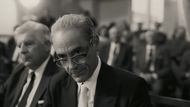Christopher Nolan's Oppenheimer is nothing short of a cinematic detonation. Barreling through ambition, a historic narrative, and atomic fallout with the intensity of a ticking bomb, the film brings to life the story of the man who gave birth to the atom bomb. But as we stumble out of the wreckage of ambition and fallout, there’s one question that keeps echoing: how much of it really happened?
Sure, the film echoes actual testimony and captures Oppenheimer’s inner collapse with chilling precision. But it also leans into spectacle, trimming inconvenient truths and dramatizing quiet tensions into thunderous confrontations. In some moments, it’s history on film. In others, it’s emotion dressed up as fact.
So what did Nolan get right? Where did he falter? And where does creative license cross the line into historical mythmaking? Let’s break it down. Because when a film this powerful rewrites the past, it’s worth asking, how much of the story survived the blast?
What Nolan gets right in Oppenheimer

Christopher Nolan doesn’t just tell the story of a man; he opens the door to a mind at war with itself. In Oppenheimer, we don’t just meet a scientist, we fall headfirst into the chaos of his mind. He’s restless, pacing through equations, half-dreaming about atoms, half-wrestling with politics. He flirts with communism in the smoky corners of 1940s America, then spends the rest of his life trying to unmake the thing he made too well.
Cillian Murphy doesn’t just play Oppenheimer; he becomes the contradiction. He’s sharp, arrogant, and magnetic in rooms full of men with chalk and ambition. But there’s this flicker, always, like something inside him is splintering. It’s the kind of performance that feels whispered from the past. Historians and biographers have called it scarily accurate, almost as if Murphy reached into the pages of American Prometheus and let the ghost of Oppenheimer crawl into his skin.

The film doesn’t shy away from Oppenheimer’s political baggage either. He did have ties to communist thinkers. He did admit to these associations under oath in 1949. And Murphy plays those moments with quiet devastation, no dramatic overkill, just a man trying to stay afloat in a world that’s suddenly tilting against him. But it’s what comes after the bomb that really hits hardest. The once confident physicist becomes a man hollowed out by guilt. The weight of his own legacy drags him down, and that unraveling is entirely true of history. Oppenheimer really did describe feeling like he had “blood on his hands.”
The Trinity Test: Fire in the Desert
No CGI. No digital shortcuts. Just Christopher Nolan, a giant steel tower, and some seriously controlled chaos.
The Trinity test sequence in Oppenheimer is pure visual poetry, and it’s surprisingly accurate. The flash of light, the agonizing delay before the sound wave, and the thunderstorm that almost shut the whole thing down? All real. Weather reports from that day confirm the test was postponed for nearly an hour, with one gutsy meteorologist betting his job on a last-minute clearing.
The final result, a silent explosion, followed by a shockwave, echoes the real accounts of witnesses like Richard Feynman. Nolan recreated it using gasoline, magnesium, and black powder, staying faithful to the physics while making it feel terrifyingly intimate. It’s not just a cinematic high, it’s a historical homage.
Lewis Strauss: The Man With the Grudge

Beneath the Senate hearings and national security drama lies something very human: bruised ego. Lewis Strauss, played with icy precision in the film, isn’t just a bureaucrat; he’s a man quietly seething. And yep, that part’s very real.
Oppenheimer leans heavily on real transcripts from the 1954 security clearance hearing and the earlier Senate confirmation debacle that took Strauss down. When Oppenheimer publicly mocked Strauss over radioisotopes, it wasn’t just banter; it was humiliation. That moment, lifted almost word for word from real records, sparked years of resentment. No wonder Robert Downey Jr won that Oscar!
Strauss’s campaign to revoke Oppenheimer’s security clearance wasn’t just a policy; it was personal. And Nolan captures that perfectly. The film doesn’t turn Strauss into a mustache-twirling villain, but it sure doesn’t let him off the hook either.
An (almost) accurate and fierce Kitty Oppenheimer, thanks to Emily Blunt

Kitty Oppenheimer burns bright in Oppenheimer, all sharp edges, stormy silences, and one unforgettable courtroom smackdown. Emily Blunt gives her grit and fury, especially in that hearing scene pulled almost word-for-word from history. But beyond the fire, something’s missing.
The real Kitty was a trained biologist who worked at Los Alamos, not just a woman drowning in martinis and loneliness. Nolan leans into tragedy, not the intellect. We see the collapse, but not the brilliance. It’s a portrait in smoke and mirrors, haunting, yes, but blurred. She’s not just a wife with a drink in her hand. She was so much more.
But here's what Oppenheimer gets wrong

Nolan’s Oppenheimer is a masterclass in tension, grief, and genius, but even masterpieces fudge the facts now and then. Beneath the sweeping score and ticking visuals, history gets a little... cinematic.
That Einstein chat? Pure fiction.
A quiet lakeside moment between two great minds? Poetic, sure. Historical? Nope. Oppenheimer never had that haunting conversation with Einstein about destroying the world. He actually voiced his fears to Arthur Compton, but let’s be real, it doesn’t hit quite the same on screen.
The Kyoto honeymoon twist
In the film, Henry L. Stimson spares Kyoto because he and his wife honeymooned there. A devastating, human moment, except it was improvised by the actor. Stimson did push to save Kyoto, but for its cultural value, not its romantic nostalgia.
Vanishing the collateral damage
The movie skips over the locals: displaced Native families, exploited workers at Los Alamos, and the devastated civilians of Hiroshima and Nagasaki. By keeping the lens on Oppenheimer, it quietly sidelines global consequences.
A moral dilemma... simplified

Nolan frames the bomb as a burdened choice. But historians say the decision was less a personal crisis, more a political steamroller. Momentum, not morality, dropped the bomb.
So yes, Oppenheimer is riveting. But it doesn’t always play fair with the facts. It’s less a historical documentary, more a fever dream of guilt, genius, and the price of power.
In the end, Oppenheimer isn’t history; it's just a recount of it. But in choosing atmosphere over accuracy, the film drifts from cold, hard fact into something more interpretive, even operatic. It’s a beautiful distortion, one that lingers like radiation. But in chasing that feeling, the film leaves some things out. The people who were pushed aside. The voices that were never heard. The truths that were too inconvenient for the cinema. And maybe that’s the tragedy, too. That we remember the man, but forget the fallout. To fully understand the legacy of the bomb, we have to look beyond the screen.
Oppenheimer is available to stream on Prime Video.
Love movies? Try our Box Office Game and Movie Grid Game to test your film knowledge and have some fun!
